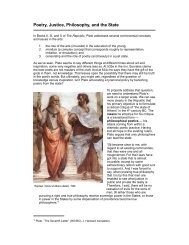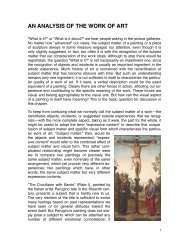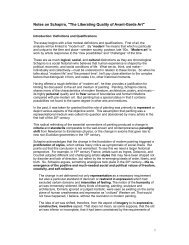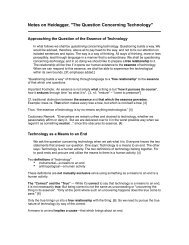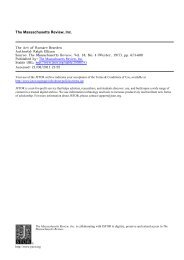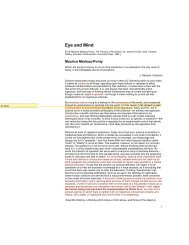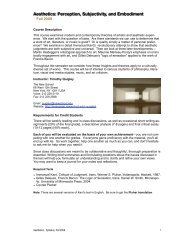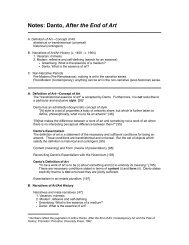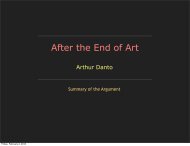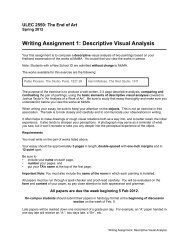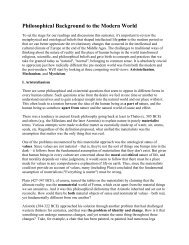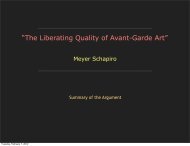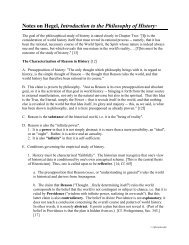PDF - Timothy R. Quigley
PDF - Timothy R. Quigley
PDF - Timothy R. Quigley
You also want an ePaper? Increase the reach of your titles
YUMPU automatically turns print PDFs into web optimized ePapers that Google loves.
Zoe Leonard,Analogue, 1998—2009, 412 C-printsand gelatin silverprints, each print28 × 28cm. Courtesythe artist and GalerieGisela Capitain,ColognePrevious spread:Zoe Leonard,Analogue,1998—2009,detailThe Archivistof Urban Waste:Zoe Leonard,Photographer asRag-Picker— Tom McDonoughAnalogue (1998—2009), Zoe Leonard’sdecade-long survey of the landscape ofsmall-scale commerce and urban servicesin New York and other cities around theglobe, began with the simple choice tophotograph the streets around her apartmenton the Lower East Side of Manhattan.As she recently recalled: ‘I began thisproject in an attempt to understand byobserving and recording the very humbleeveryday surroundings of my everydaylife.’ 1 What would grow into an archiveof more than 400 images, displayed inserial grids organised in loosely thematicIn this close reading of Zoe Leonard’sAnalogue, Tom McDonough considersits mapping of reclamation and exchangeas a model for artistic practice.groupings, originated with this impulseto document the changing texture of hertraditionally working-class and ethnicallydiverse district as it was being overtaken bythe deterritorialising force of capital: ‘Myown neighbourhood is filled with the signsof a local economy being replaced by aglobal one,’ Leonard remarked, ‘smallbusinesses being replaced by largecorporations, multinationals taking over.’ 2A relatively early photograph from theseries (from 1999), depicts a small storefront,seen straight on, in a square-formatblack-and-white print. The address — onLudlow just above Delancey Street — wasoccupied in the late 1990s by the ActiveServices Corporation, which performeda variety of functions for its primarilySpanish-speaking clientele, from incometax preparation to rapid divorces, allof which was spelled out in a patchworkof signage posted in its windows andhand-painted on the awning above.The visitor to this address today will findinstead itsasickness, a boutique sellinggifts and accessories loosely themed onaddiction (the shop’s website encouragesusers to indulge their ‘obsessive behavior’).The transformation is indicative of thedisappearing social world Leonard setout to capture, and of what is replacing it.As a document of the contemporaryurban landscape, Analogue could be saidto stand at the intersection of competingregimes of representation. With theirdeadpan gaze, standardised format andgridded presentation, the photographs owean obvious debt to conceptual precedents.They often have been compared, forexample, to the industrial typologiesassembled by Bernd and Hilla Becher,and the two bodies of work do indeed sharea kind of archaeological impulse, a desireto picture what are often obsolescent formsbefore their final disappearance. ButLeonard’s focus on the city, and in particularon its working-class quarters, mightalso recall Hans Haacke’s investigationsof New York real estate as a ‘social system’,most famously in Shapolsky et al. ManhattanReal Estate Holdings, a Real TimeSocial System, as of May 1, 1971 (1971).That controversial work, at the centre ofthe Guggenheim Museum’s last-minutecancellation of Haacke’s solo exhibitionthe year of its production, mapped out thetransactions of a shadowy real estate firmcentred upon one of the largest holders ofslum properties in Manhattan. Shapolskyet al. consisted of 142 photographs of thebuildings and lots owned by the firm —most on the Lower East Side and in Harlem— each of which was accompanied by atext panel describing its location and thefinancial deals involving the building,along with six charts cross-referencing theproperties, an explanatory wall panel and1 Zoe Leonard, quoted in Drusilla Beyfus, ‘Zoe Leonard: Deutsche Börse Photography Prize 2010’,The Daily Telegraph, 11 February 2010; see http://www.telegraph.co.uk/culture/photography/7205995/Zoe-Leonard-Deutsche-Borse-Photography-Prize-2010.html (last accessed on 24 May 2010).2 Z. Leonard, quoted in ‘Eminent Domain: Contemporary Photography and the City’, at the New York PublicLibrary, 2008; see http://exhibitions.nypl.org/exhibits/eminent/leonard (last accessed on 24 May 2010).20 | Afterall Artists: Zoe Leonard | 21
maps. The effect of the work was to makelegible the opaque connections betweenvarious dummy corporations that togethercontrolled an exploitive market forlower-income housing. There can be noquestioning of the distance that separatesHaacke’s rigorous investigation ofthis particularised social system fromLeonard’s wide-ranging visualisationof the ecology of small-scale commerce,and it would be facile to locate a morphologicalsimilarity between the worksby isolating Haacke’s photographsand comparing them with Leonard’s.Nevertheless, a connection between thesetwo disparate works remains.The conjunction lies less perhaps inHaacke’s piece itself than in its receptionin New York in the mid-1980s, when, inan influential reading, Rosalyn Deutscheargued that it sited itself critically within‘a specific interface between economic andartistic concerns — the relations betweendominant aesthetic discourses and theinterests of real estate capital in NewYork’. 3 Shapolsky et al. held particularresonance in a city that was finally absorbingthe successful outcome of a half-centuryof efforts by large landowners to rid it ofindustrial employment as part of a broaderreorganisation of the division of labour onnational and international scales. By theend of the 1980s manufacturing had givenway to the characteristic contemporarymix of jobs in services and finance,insurance and real estate, a process thatwas accompanied by the marginalisationof the people who had been employed insmall industry as low-rent propertiesdisappeared. ‘The latest phase of urbanredevelopment,’ Deutsche concluded,‘also engineers the destruction of thematerial conditions of survival — housingand services — for those residents no longerneeded in the city’s economy.’ 4 In thismanner Shapolsky et al. was articulated asa precedent for projects by Group Materialand Martha Rosler, which took upgentrification in 1980s New York in asimilar manner, critically engaging boththe urban landscape and a culturalapparatus that all too often was complicitwith the redevelopment process. Analoguecan be seen as marking the latest, andperhaps last, movement in this arc: bythe early 1990s the deindustrialisation ofManhattan was a fait accompli, and thehousing battles of the previous decade hadbeen lost. What remained was to captureon film a residual environment of cheapclothing shops, appliance stores andthe like that served a surplus population,before it, too, was obliterated by the bubbleeconomy of the late 1990s and 2000s. 5However the factographic rigour ofthese conceptual precursors of Analoguecoexists — rather uneasily — alongside amore poetic lineage of street photography,which constitutes another crucial interlocutorfor the project. Lee Friedlander’s1960s photographs of shop windows mightcome to mind, although his interest in theambiguity between reflection and actualityis largely foreign to Leonard’s series.We do occasionally glimpse her mirroredimage in a store’s glass frontage, standingat a certain distance from her subject — asin the photograph showing the corner ofLudlow and Rivington Street (from 1999),in which we can just make her out, perchingat the edge of the curb as she peers downinto the focusing screen of her Rolleiflexcamera. Her form, silhouetted dimlyagainst the empty jackets arrayed in thewindow, creates that intermingling ofoutside event with inside displays so typicalof Friedlander. But this is something of ananomaly; throughout Analogue Leonardgenerally avoided these sorts of effects,photographing in the cool, even light ofearly morning and minimising reflections.A closer parallel might be found in therather lesser-known colour photographs ofworking-class storefronts taken by HarryCallahan in Chicago in the mid-1950s. LikeLeonard’s, these pictures were motivatedby knowledge of the impending doom ofthe spaces depicted, slated as they were for‘renewal’ at an earlier moment of municipalreorganisation. Callahan was teachingat the time at the Institute of Design, wherehe had befriended Ludwig Mies van derRohe; the modest vernacular commercialarchitecture captured by Callahan’sphotographs, and the fine-grained urbantexture it established, stood as an implicit3 Rosalyn Deutsche, ‘Property Values: Hans Haacke, Real Estate and the Museum’, in Brian Wallis (ed.),Hans Haacke: Unfinished Business, New York, Cambridge, MA and London: The New Museum ofContemporary Art and The MIT Press, 1986, p.23.4 Ibid., p.24.5 For a complementary reading of this work, see Jenni Sorkin, ‘Finding the Right Darkness’, frieze,issue 113, March 2008; also available at http://www.frieze.com/issue/article/finding_the_right_darkness (last accessed on 24 May 2010).Zoe Leonard,Analogue, 1998—2009, 412 C-printsand gelatin silverprints, each print28 × 28cm. Courtesythe artist and GalerieGisela Capitain,Cologneriposte to the latter’s crystalline vision ofa city purged of density — a vision that wasbuilt, in the form of his Lake Shore Driveapartments, only a mile or so away on theaffluent Gold Coast from the strip shownin Callahan’s photographs. They confrontthe subjects straight on, the door positionedat the centre of the picture, so that the imagebecame an intricate composition of squaresand rectangles. Leonard’s photographs ofPitt Street or of Clinton Street (both takenin 1999 in New York City) echo, perhapsinadvertently, Callahan’s formats in theircompositional rigour.But of course the great photographicprecedent for Analogue, as so many ofits commentators have remarked and asLeonard herself has attested, lies in thedocumentation of ‘Old Paris’ undertakenby Eugène Atget at the start of the twentiethcentury. The photographs of Broadwayand Grand Street or of Orchard Street(both 1999), with their stacked bolts offabric or groaning racks of dress shirts,bear close comparison to the series ofphotographs taken by Atget in 1910 and1911 at the Marché des Carmes on thePlace Maubert, where clothing merchantsdisplayed their wares. What Leonard seesin the French photographer is neither thecelebration of the ‘social fantastic’ laudedby Pierre Mac Orlan nor the revelation ofthe uncanny admired by the Surrealists,but the documentation of a particularkind of selling: that of secondhand goods,of salvage, of reutilisation. Atget’s market,or his dealers in used wares, depicts aform of commerce that developed out ofnecessity to serve the Parisian underclass,and stands in sharp distinction to the22 | Afterall Artists: Zoe Leonard | 23
spectacle of the department store and itsdeployment of the narcissistic mirrorof consumption. 6 So too Leonard’s smallshops are counterposed to those nationalchains, unseen, that were spreadingthroughout New York in those years,choking off this local ecology of familybusinesses. This aspect of Analogue onlybecame more pronounced as the projectdeveloped, and assumed an increasinglyself-reflexive quality: one significantsubset of images depicts shops selling andrepairing obsolescent visual technologies— as in Roger’s TV Service in the photographof Avenue B (2000), seen from aslightly oblique angle with its array oftelevisions, stereo equipment and radiosposed in its window and on the sidewalk.(Roger’s has since given way to ShampooAvenue B, a hair salon boasting Lady Gagaas a client; cuts start at $80 for women.)These disappearing visual technologies, andthe material spaces that sold and repairedthem, are indemnified in memory throughanother threatened technology — Leonard’sRolleiflex camera — producing a kind oftriangulated mirroring between the cameralens, TV screens and the shop window.Zoe Leonard began Analogue, asstated earlier, by walking through herneighbourhood and similar workingclasscommercial districts in Manhattan6 See Clive Scott, Street Photography: From Atget to Cartier-Bresson, London and New York: I.B. Tauris,2007, p.74, for a useful discussion of Atget’s images of Parisian commerce. Leonard’s primaryreference was to Molly Nesbit, Atget’s Seven Albums, New Haven and London: Yale University Press,1992.Zoe Leonard,Analogue, 1998—2009, 412 C-printsand gelatin silverprints, each print28 × 28cm. Courtesythe artist and GalerieGisela Capitain,Cologneand Brooklyn. Favouring the morning,when the sidewalks were empty ofpedestrians, she photographed thosederelict or down-at-heel storefrontsthat caught her eye. Her peripatetic gazeis a distant echo of one of the foundingparadigms of modernist artistic production:that which compared the artist to thechiffonnier, the rag-picker who scavengedthe daily cast-offs of the great city:Here is a man entrusted to gather upthe remains of a day in the life of thecapital. All that the metropolis hasrejected, all that it has got rid of,all that it has scorned, all thatit has broken, he catalogues, hecollects. He examines the archivesof debauchery, the capharnaüm[a dump, a pigsty] of trash. He makesa selection, an intelligent choice;he gathers, like a miser a treasure,the refuse that, when ground againbetween the jaws of the goddessIndustry, will become objects of utilityor of delight. 7That was Charles Baudelaire writingin his 1851 essay ‘On Wine and Hashish’,at the very dawn of those forms ofconsumer capitalism that today flourishThese disappearing visual technologies,and the material spaces that sold and repairedthem, are indemnified in memory throughanother threatened technology — Leonard’sRolleiflex camera.so abundantly. Perhaps the most radicalaspect of this profile of an ‘archivist’ ofurban waste was its implicit redefinitionof art-making under the transformedconditions of modern urban life and theincipient regime of the commodity, whichwould now of necessity become a labourof scavenging, of making meaningfulwhat happened to be left at one’s disposal. 8Baudelaire sensed this to be the casealready in his lifetime, and eulogised therag-picker in his poetry: the two shared asecret complicity, as the discarded clothingthe latter collected was sold to be remadeinto paper, the very physical supportfor the poet’s work; but more importantly,Baudelaire positioned his writing inan analogous relationship to the city,salvaging bits of urban detritus in hispoems. ‘Lumpensammler oder Poet —der Abhub geht beide an,’ Walter Benjaminremarked in regard to this Baudelaireananalogy: ‘rag-picker or poet — refuseconcerns both’. 9 We might say somethingsimilar of Analogue and its maker,that Abhub — refuse, garbage, thediscarded and scorned — is at the centreof their concerns.These connections are perhaps mostclearly articulated in a series of photographsthat began in 2001, when Leonardwas exploring the streets of Williamsburgin Brooklyn. Walking through a districtof warehouses, small-scale industryand wholesalers found just north of theBrooklyn-Queens Expressway, she foundlarge bales of used clothing stacked up onthe sidewalk, of which she made a numberof colour and black-and-white images,such as the photograph of Leonard Street,in Williamsburg, Brooklyn (2001), withits sculptural array of bundles shot atan angle against the red-brick wall of thebuilding behind. Three years later, Leonardwas able to trace the itinerary of theseused clothes, which— like the majorityof garmentsdonated to charitableorganisationsin the US —were destinedfor markets in thedeveloping world. In 2004 she visitedUganda and photographed the stalls anddisplays of local vendors, the end point of along trajectory that began in donation binsin New York, to the kind of wholesalershe encountered on Leonard Street inBrooklyn, through worldwide buyers,and on to the streets of cities like Kampala.What is unwanted trash in the US returnsas coveted goods in the Global South,in an early twenty-first century update ofBaudelaire’s chiffonnier. For this trajectoryis indeed very contemporary: only since theearly 1990s, and the imposition by the US7 Charles Baudelaire, ‘On Wine and Hashish’, Artificial Paradises (ed. and trans. Stacy Diamond),New York: Citadel Press, 1996, p.7. Translation modified by the author.8 These terms are derived from Ewa Lajer-Burcharth’s outstanding discussion of this Baudelaire essay,found in her ‘Modernity and the Condition of Disguise: Manet’s “Absinthe Drinker”’, Art Journal,vol.44, no.1, Spring 1985, pp.21—22.9 Walter Benjamin, Charles Baudelaire: A Lyric Poet in the Era of High Capitalism (trans. Harry Zohn),London: New Left Books, 1973, p.80. Translation modified by the author.24 | Afterall Artists: Zoe Leonard | 25
and the IMF of trade liberalisation on theformerly protected economies of muchof the developing world, has this trade inused clothing flourished. What Leonardcaptures in her Kampala photographs is ina sense the opposite of what she had beendocumenting in New York — not a residualeconomy being eradicated by global capital,but an emergent formation linked preciselyto those transnational flows of money andcommodities. 10This is not to claim that the politicsof this global trade appears as Leonard’s‘subject’ in these photos, much less thatshe is offering a critique of this dynamic;the rise of an international trade in usedclothes constitutes the horizon of possibilityfor these images, but their resolute focuson the point-of-sale in conjunction withthe earlier images of bales in New Yorkperhaps suggests her interest lies in whatArjun Appadurai has called ‘the social lifeof things’, or in a ‘biographical approach tothings’ (a particular approach that has longexisted within Leonard’s oeuvre, from theTrophies and Wax Anatomical Modelsto Strange Fruit and 1961, works spanningthe late 1980s through the later 1990s). 11In this sequence of Analogue she takesa processual view of her subject, tracingsomething like the life history of thiscommodity; we grasp the passage fromclothing-as-use, to its withdrawal fromusage, to its re-inscription within acommodity circuit, and a presumedsecond life in Africa. Mitumba and salaula(Swahili words for ‘used clothing’) becomethe latter-day echo of New York’s schmattezamlers — as the used-clothing dealerswere known in this predominantly Jewishneighbourhood — and Paris’s chiffonniers.And once again a self-reflexivity — ananalogy between clothes and photographs— can be apprehended here: the circulationof these used garments stands in somerelation to the circulation of her images.(And wasn’t there something fated inthe coincidence of encountering theused-clothing processor on a street name,Leonard, that is also hers?) ‘Images’ isthe wrong word in any case, since sheinsists on the materiality of the photographand its support, in distinction to thecontemporary turn toward digitisedmobility and the dematerialisation of theimage in projection: ‘I […] love how tactilea photograph is; [its] physical presenceis very beautiful to me.’ 12 Hence herpredilection for the postcard — whosecollection and display has occupied heralmost exclusively in the years sincecompleting Analogue — in which thephotograph becomes a physical meansof exchange and communication throughspace, a kind of token passed from handto hand. It is perhaps relevant to add herethat, in addition to its presentation as alarge-scale installation and as a smallerportfolio of prints, Analogue exists as anartist’s book, whose buckram cover recallsthe standard library binding of oldervolumes and hence emphasises its passageamong multiple readers.Appadurai, in tracing the social lifeof things, was interested not only intheir movement along well-trodden pathsof commodity exchange but also in thepossibilities for more eccentric diversionsor subversions. Take the collector, forexample, who removes or protects objectsfrom the commodity context, who‘enclaves’ them in a special zone outsidethe regulated flow of things. But thatgesture, as he notes, is fundamentallyambivalent, since ‘such diversion is notonly an instrument of decommoditisationof the object, but also of the (potential)intensification of commoditisation by theenhancement of value attendant upon itsdiversion’. 13 The rag-picker as an analogueof the artist contains something of the sameduality, on one hand embodying devotionto what has been rejected, cast off fromthe circulation of the capitalist economy— since ‘it is precisely when they no longercirculate, as well-behaved commoditiesshould, that things begin to give signs ofa more subversive potential’ — while onthe other hand occluding what TheodorAdorno called, in a famous riposte to10 The best account of this trade is found in Karen Tranberg Hansen, Salaula: The World of SecondhandClothing and Zambia, Chicago and London: University of Chicago Press, 2000, although its focus onidentity formation and consumer choice obscures the broader political dynamic. A good, journalisticaccount may be found in George Packer, ‘How Susie Bayer’s T-Shirt Ended Up on Yusuf Mama’s Back’,The New York Times Magazine, 31 March 2002. For the context of post-1989 trade liberalisation,see Naomi Klein, The Shock Doctrine, New York: Picador, 2007.11 See Arjun Appadurai, ‘Introduction: Commodities and the Politics of Value’, in A. Appadurai (ed.),The Social Life of Things: Commodities in Cultural Perspective, Cambridge and New York: CambridgeUniversity Press, 1986, p.13.12 Z. Leonard, quoted in ‘Zoe Leonard Interviewed by Anna Blume’, in Kathrin Rhomberg (ed.),Zoe Leonard (exh. cat.), Vienna: Secession, 1997, p.12.13 A. Appadurai, ‘Introduction’, op. cit., p.28.Zoe Leonard,Analogue, 1998—2009, 412 C-printsand gelatin silverprints, each print28 × 28cm. Courtesythe artist and GalerieGisela Capitain,CologneBenjamin’s characterisation, ‘the capitalistfunction of the rag-picker — namely, tosubject even rubbish to exchange-value’. 14If poverty is not exactly made beautifulin Analogue, the dereliction of the urbanlandscape is brought within the precinctsof the museum, where it coexists uneasilywith its surroundings.One more word is in order, however,before we leave this account of the artistas-chiffonnier.For the analogy has been,throughout its history, a resolutelymasculine one, closely bound up with thatliterature of modernity that has characterisedthe modern city as a male preserve andrelegated women to the domestic sphere. 15Indeed, such an explanation of Analoguerisks separating it entirely from Leonard’slongstanding queer and feminist practice,but there are compelling links between thisproject and the larger concerns of her workthat allow us to see it, too, as somehowcontinuous with her gender politics. Mostnotably, the elegiac quality of Analogue— the mourning for a lost city — binds it toother works of mourning tied to the AIDScrisis; this is clearest in the photographsdepicting abandoned storefronts where justthe ghost of old signage remains, such as theimage of Grand Street in Brooklyn (2001)14 See Irving Wohlfarth, ‘Et Cetera? The Historian as Chiffonnier’, in Beatrice Hanssen (ed.), WalterBenjamin and The Arcades Project, London and New York: Continuum, 2006, p.15. For the Adorno quote,see Theodor Adorno and W. Benjamin, The Complete Correspondence, 1928—1940 (ed. Henri Lonitz,trans. Nicholas Walker), Cambridge, MA and London: Harvard University Press, 1999, p.284.15 The classic analysis remains Janet Wolff, ‘The Invisible Flâneuse: Women and the Literature ofModernity’, Theory, Culture & Society, vol.2, no.3, 1985, pp.37—46.26 | Afterall Artists: Zoe Leonard | 27
Zoe Leonard,The Fae RichardsPhoto Archive,1993—96 (createdfor Cheryl Dunye'sfilm The WatermelonWoman, 1996),78 black-and-whitephotographs, 4 colourphotographs andnotebook of 6 pagesof typed text ontypewriter paper.Installation view,Whitney Biennial,Whitney Museumof American Art,New York, 1997.Photograph:Geoffrey Clemens.Courtesy the artistor Manhattan Avenue in Greenpoint,Brooklyn (2006), which recall the driedhusks of Strange Fruit (1992—97), a bodyof work begun in the wake of DavidWojnarowicz’s death. Something similarmay be detected in the prevalence ofanalogues for the human body or, to bemore precise, for absent couples — pairsof empty chairs in the image of RivingtonStreet or of Avenue A, or two pairs of shoesin the photograph of Praga Market inWarsaw (all 1999). But we could say thatthere is something generally queer aboutthe archive constituted by Analogue, that itsconjunction of conceptual documentationand personal idiosyncrasy derives preciselyfrom an awareness that lesbian and gayhistory has made clear that an archive‘must preserve and produce not justknowledge but feeling’, that in fact thearchive is a site of ‘profoundly affectivepower’. 16 Analogue, like her explicitlyqueer documents such as The Fae RichardsPhoto Archive (1993—96), mobilisesmemory and affect to compensate forinstitutional neglect, now on the urbanscale itself.stark dichotomy of small business/largecorporation implies what we might callan ecological view of the urban economy,with local stores that created a responsive,equilibrated ecosystem being eradicatedby the invasive species of multinationalbrands, the ‘honest’ commerce of theformer undone by the wastefulnessof the latter. These views were alreadytaking shape upon her return from a tripto India in late 1992, where she ‘wasimpressed with how each scrap of paper[…] was used to its maximum, to the veryend of its possible useful life’, and furtherelaborated during her long sojourn inbackwoods Alaska. 17The link is made clear in a recentinterview, in which Leonard elaboratesa series of questions implied in the photographs,and in her approach toward hersubjects: ‘How am I connected to peoplewho make my clothes, to people who buyand sell my clothes and food? Who benefitsfrom the connection? Who suffers from theconnection?’ 18 But the contemporary urbanlandscape is no distortion, and the dynamictransformation of the city recorded inWaste, ruin, destruction are constitutive of present order,not mere surplus negativity, and capitalism thrives on crisis,not equilibrium. Analogue brilliantly captures the surface ofthis world, the regrettable symptoms of an irrational economy.If this series looks back to a longerhistory of recording the lived effects ofcapitalism on modern urban agglomerations,and constitutes one of the mostchallenging and remarkable photographicdocuments of the present, we may neverthelessdiscern some of its ideological limitsin the quoted description with which webegan. There is much force in the statement‘my own neighbourhood is filled with thesigns of a local economy being replacedby a global one, small businesses beingreplaced by large corporations, multinationalstaking over’, but perhaps alsoas much misrecognition; it was not onlymultinationals that were pushing outher mom-and-pop businesses, but moretypically, as we have seen, other small,entrepreneurial shops now serving anentirely different social class. Leonard’sAnalogue is no alien excess imposed on amore natural arrangement. ‘People whodenounce incitements to wastefulnessas absurd or dangerous in a society ofeconomic abundance do not understandthe purpose of waste,’ noted Guy Debordsome four decades ago. 19 Waste, ruin,destruction are constitutive of presentorder, not mere surplus negativity, andcapitalism thrives on crisis, not equilibrium.Analogue brilliantly captures thesurface of this world, the regrettablesymptoms of an irrational economy, butit cannot name the cause itself. And in that,it truly marks the ideological limits of acertain practice of photography as well.16 Ann Cvetkovich, ‘In the Archives of Lesbian Feelings: Documentary and Popular Culture’,Camera Obscura, no.49, 2002, pp.109—10.17 Z. Leonard, quoted in ‘Zoe Leonard Interviewed by Anna Blume’, op. cit., p.17.18 Z. Leonard, quoted in Beyfus, ‘Zoe Leonard’, op. cit.19 Guy Debord, The Society of the Spectacle (trans. Donald Nicholson-Smith), New York: Zone Books, 1994,p.140.28 | Afterall Artists: Zoe Leonard | 29



